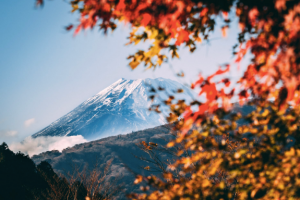Tracing Volcanic Eruptions using Strontium Isotopes

Volcanic eruptions are significant geological events with far reaching implications. The analysis of isotopes in various sample types can provide information on the timing and magnitude of past volcanic eruptions.
Imprints of volcanic eruptions within archaeological isoscapes
Strontium isotopes (87Sr/86Sr) are commonly used in archeological studies of trade and mobility by tracing the strontium signature in a human or organism with local bedrock geology. However, volcanic eruptions can displace and deposit sediments across landscapes on short timescales, leading to variability in bedrock geology downwind of volcanic eruptions. Without accounting for this variability, isoscape interpretations could result in erroneous paleomobility interpretations. To eliminate this uncertainty, known variations in 87Sr/86Sr along a predictable pathway from a volcanic center can be used to pinpoint and trace the pathway of past eruptions. For example, Serna et al. (2020) demonstrated that a 87Sr/86Sr terrestrial isoscape can be developed in volcanic regions (e.g. Northern Patagonia) to allow for paleomobility research spanning the Holocene despite volcanic sediment interferences.
Read more about strontium isotopes in diet and migration studies.
Hints of volcanic activity in sediments and trees
Beyond terrestrial strontium variability, volcanic activity can imprint changes in 87Sr/86Sr signatures within lake and ocean sediments. Bagherpour et al. (2018) analyzed 87Sr/86Sr within an inland sea deposit from South China covering the late Permian. The authors found a transient shift in 87Sr/86Sr concurrent with a carbon isotope (δ13C) excursion, recording a short-term enhancement of volcanic activity within the Emeishan Large Igneous Province.

In addition to sediment records, volcanic activity can be traced through isotopes within tree-rings. Large volcanic eruptions can lead to widespread climate perturbations, as demonstrated by the Late Antiquity eruptions occurring between AD 536-540 in Iceland, South Asia North America and the tropics. This series of eruptions led to climate cooling across Europe, associated with failures of crops and ultimately famine. Helama et al. (2018) measured carbon isotopes (δ13C) in tree-rings, finding a significant negative excursion spanning the Late Antiquity eruptions, reflecting reduced solar radiation from a volcanic dust veil in the atmosphere. Similar negative δ13C excursions have been demonstrated in trees resulting from volcanic activity at Mt. Etna, Italy (Seiler et al. 2021).
Read more about strontium isotope applications.
Tracing origins of volcanic activity using multiple isotopes
While strontium isotopes alone can be used to trace volcanic activity, the combination of multiple trace isotopes (e.g. Sr-Nd-Pb) can be analyzed to reconstruct lava origin and its tectonic setting. Rasoazanamparany et al. (2016) analyzed lava and tephra deposits from a volcanic eruption occurring between 1759-1774 in Mexico. The authors were able to distinguish “arc-like” patterns in the isotopic signatures of volcanic rocks with enrichments in mobile lead (Pb) associated with depletions in immobile Rubidium (Rb) and explicit variations in strontium (87Sr/86Sr), neodymium (143Nd/144Nd) and hafnium (176Hf/177Hf). These results demonstrate heterogeneity in the source mantle rock, likely originating from the North Mexican Extensional Province. Such distinct signatures in mantle have been found in many other studies using similar isotopic analyses. For example, Finlayson et al. (2018) was able to match the Hawaiian Tuvalu Island volcanic chain to a specific hotspot origin site based on rock compositions of high Pb (206Pb/204Pb) paired with low strontium (87Sr/86Sr).
Read more about Sr-Nd-Hf systematics.
Sample Analysis
At Isobar Science, strontium isotopes (87Sr/86Sr) and strontium concentrations can be analyzed in numerous different sample types including igneous rocks, mineral dust and sediments. All analyses are reported within a 95% confidence interval. Contact us today to discuss your project.
UPDATE: Isobar Science discontinued the Nd-Hf service starting January 2024.
References
Bagherpour, B., Bucher, H., Schneebeli-Hermann, E., Vennemann, T., Chiaradia, M. and Shen, S.Z., (2018). Early Late Permian coupled carbon and strontium isotope chemostratigraphy from South China: Extended Emeishan volcanism?. Gondwana Research, 58, pp.58-70.
Finlayson, V.A., Konter, J.G., Konrad, K., Koppers, A.A.P., Jackson, M.G. and Rooney, T.O., (2018). Sr–Pb–Nd–Hf isotopes and 40Ar/39Ar ages reveal a Hawaii–Emperor-style bend in the Rurutu hotspot. Earth and Planetary Science Letters, 500, pp.168-179.
Helama, S., Arppe, L., Uusitalo, J., Holopainen, J., Mäkelä, H.M., Mäkinen, H., Mielikäinen, K., Nöjd, P., Sutinen, R., Taavitsainen, J.P. and Timonen, M., (2018). Volcanic dust veils from sixth century tree-ring isotopes linked to reduced irradiance, primary production and human health. Scientific Reports, 8(1), pp.1-12.
Rasoazanamparany, C., Widom, E., Siebe, C., Guilbaud, M.N., Spicuzza, M.J., Valley, J.W., Valdez, G. and Salinas, S., (2016). Temporal and compositional evolution of Jorullo volcano, Mexico: implications for magmatic processes associated with a monogenetic eruption. Chemical Geology, 434, pp.62-80.
Seiler, R., Hajdas, I., Saurer, M., Houlié, N., D’Arrigo, R., Kirchner, J.W. and Cherubini, P., (2021). Tree‐ring stable isotopes and radiocarbon reveal pre‐and post‐eruption effects of volcanic processes on trees on Mt. Etna (Sicily, Italy). Ecohydrology, p.e2340.
Serna, A., Prates, L., Mange, E., Salazar-García, D.C. and Bataille, C.P., (2020). Implications for paleomobility studies of the effects of quaternary volcanism on bioavailable strontium: A test case in North Patagonia (Argentina). Journal of Archaeological Science, 121, p.105198.
Image References
Volcano at night: https://www.pexels.com/photo/volcano-eruption-6307488/
Volcano with branches: https://www.pexels.com/photo/scenic-photo-of-mountain-during-daytime-3917809/
